Play video — original link
Play video
Play video

ENVIRONMENTAL COMMISSION MOTION 20250507-004 Date: May 7, 2025 Subject: PSH – LifeWorks at Tillery, SP-2025-0031C.SH Location: 819 Tillery Street, Austin, TX, 78702 Motion by: Hanna Cofer Seconded by: Jennifer Bristol WHEREAS, the Environmental Commission recognizes the applicant is seeking removal of a Heritage tree with a stem greater than 30 inches in accordance with LDC § 25-8-643 and § 25-8- 624(A)(2); and WHEREAS, the Environmental Commission recognizes that the tree requested for removal is a 32-inch diameter Heritage pecan (Tree #3510), located within the one-acre lease area designated for Permanent Supportive Housing (PSH) on a 13-acre site; and WHEREAS, the Environmental Commission recognizes that the City Arborist rates the pecan tree as being in fair overall condition but with poor structural integrity, a moderate risk rating, and documented defects including large limb failures and a significant defect at the main branch union; and WHEREAS, the Commission acknowledges that on-site evaluations included a Resistograph analysis and private arborist climbing inspection that confirmed internal structural weaknesses at various heights along the trunk, despite no internal decay at the base; and WHEREAS, the Commission understands that the applicant demonstrated multiple constraints—including the tree’s central location in the buildable area, site design limitations, lack of feasible alternatives, and funding constraints for vertical development—that prevent reasonable use of the property if the tree is retained; and WHEREAS, the City Arborist has recommended approval of the variance request after determining that the criteria in LDC § 25-8-624(A)(2) have been met, and that no waivers or design modifications are available to reasonably preserve the tree; and WHEREAS, the applicant has committed to the preservation of other Heritage trees on site, in compliance with ECM Section 3.5.2, and will provide required mitigation through a payment of $7,200 to the Urban Forest Replenishment Fund in accordance with ECM standards for certified affordable housing developments; 1 THEREFORE, the Environmental Commission recommends approval of the requested variance with the following conditions: 1. The applicant shall submit and implement a Care Plan for the duration of the lease for the 34 preserved Heritage trees, including routine inspection, pruning, mulching, watering, and pest management, to ensure long-term health and viability. 2. The applicant shall coordinate with City of Austin Urban Forestry Program staff to identify and implement one-time improvements to existing or new streetscape trees as needed, within the public right-of-way adjacent to the project site. 3. Annual reports shall be submitted to …

ENVIRONMENTAL COMMISSION MOTION 20250507-005 Date: May 7, 2025 Subject: McLemore Tract Multifamily Water and Wastewater Service Extension Request #6139 and 6140 Location: 10656 N FM 620 Rd, Austin, Texas 78726 Motion by: Hanna Cofer Seconded by: Mariana Kruger WHEREAS, the Environmental Commission recognizes the applicant is requesting Service Extension Requests (SERs) for water and wastewater located outside of the City of Austin’s full purpose jurisdiction. This site opted to remove itself from the City of Austin’s ETJ in September 2024. WHEREAS, the Environmental Commission recognizes the site is located in Lake Travis Watershed, North Edwards Aquifer Recharge Zone, and the Drinking Water Protection Zone, and WHEREAS, the Environmental Commission recognizes that Staff does not recommend the SER. THEREFORE, the Environmental Commission DOES NOT recommend Service Extension Request #6139 and 6140 for the following reasons: 1. The proposed 10-acre development would propose approximately 59% impervious cover. The proposed development includes parking that covers approximately 34% of the property. If the applicant were required to comply with City of Austin environmental standards, the impervious cover would be limited to 20% of the net site area. 2. The site is also within the North Edwards Aquifer Recharge Zone and is upstream of known Jollyville Plateau salamander habitat. 3. The City of Austin’s Land Development Code limits construction on slopes greater than 15% and the proposed project plans to build on slopes greater than 15%. 4. The site has soil that limits OSSF or TLAP systems. VOTE 10-0 For: Jennifer Bristol, Mariana Krueger, Hanna Cofer, Richard Brimer, Isabella Changsut, Annie Fierro Justin Fleury, Ashika Ganguly, Haris Qureshi, Martin Luecke Against: None Abstain: None Recuse: None Absent: David Sullivan 1 Approved By: Jennifer Bristol, Environmental Commission Chair 2
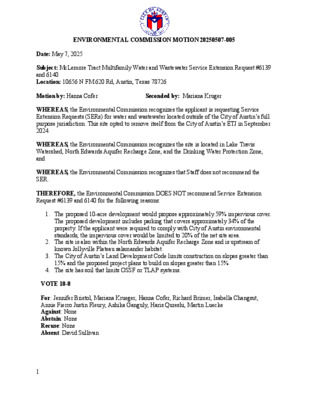
ENVIRONMENTAL COMMISSION MOTION 20250507-005 Date: May 7, 2025 Subject: McLemore Tract Multifamily Water and Wastewater Service Extension Request #6139 and 6140 Location: 10656 N FM 620 Rd, Austin, Texas 78726 Motion by: Hanna Cofer Seconded by: Mariana Kruger WHEREAS, the Environmental Commission recognizes the applicant is requesting Service Extension Requests (SERs) for water and wastewater located outside of the City of Austin’s full purpose jurisdiction. This site opted to remove itself from the City of Austin’s ETJ in September 2024. WHEREAS, the Environmental Commission recognizes the site is located in Lake Travis Watershed, North Edwards Aquifer Recharge Zone, and the Drinking Water Protection Zone, and WHEREAS, the Environmental Commission recognizes that Staff does not recommend the SER. THEREFORE, the Environmental Commission DOES NOT recommend Service Extension Request #6139 and 6140 for the following reasons: 1. The proposed 10-acre development would propose approximately 59% impervious cover. The proposed development includes parking that covers approximately 34% of the property. If the applicant were required to comply with City of Austin environmental standards, the impervious cover would be limited to 20% of the net site area. 2. The site is also within the North Edwards Aquifer Recharge Zone and is upstream of known Jollyville Plateau salamander habitat. 3. The City of Austin’s Land Development Code limits construction on slopes greater than 15% and the proposed project plans to build on slopes greater than 15%. 4. The site has soil that limits OSSF or TLAP systems. VOTE 10-0 For: Jennifer Bristol, Mariana Krueger, Hanna Cofer, Richard Brimer, Isabella Changsut, Annie Fierro Justin Fleury, Ashika Ganguly, Haris Qureshi, Martin Luecke Against: None Abstain: None Recuse: None Absent: David Sullivan 1 Approved By: Jennifer Bristol, Environmental Commission Chair 2
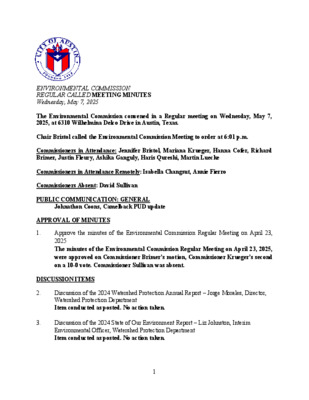
ENVIRONMENTAL COMMISSION REGULAR CALLED MEETING MINUTES Wednesday, May 7, 2025 The Environmental Commission convened in a Regular meeting on Wednesday, May 7, 2025, at 6310 Wilhelmina Delco Drive in Austin, Texas. Chair Bristol called the Environmental Commission Meeting to order at 6:01 p.m. Commissioners in Attendance: Jennifer Bristol, Mariana Krueger, Hanna Cofer, Richard Brimer, Justin Fleury, Ashika Ganguly, Haris Qureshi, Martin Luecke Commissioners in Attendance Remotely: Isabella Changsut, Annie Fierro Commissioners Absent: David Sullivan PUBLIC COMMUNICATION: GENERAL Johnathon Coons, Camelback PUD update APPROVAL OF MINUTES 1. Approve the minutes of the Environmental Commission Regular Meeting on April 23, 2025 The minutes of the Environmental Commission Regular Meeting on April 23, 2025, were approved on Commissioner Brimer’s motion, Commissioner Krueger’s second on a 10-0 vote. Commissioner Sullivan was absent. DISCUSSION ITEMS 2. 3. Discussion of the 2024 Watershed Protection Annual Report – Jorge Morales, Director, Watershed Protection Department Item conducted as posted. No action taken. Discussion of the 2024 State of Our Environment Report – Liz Johnston, Interim Environmental Officer, Watershed Protection Department Item conducted as posted. No action taken. 1 PUBLIC HEARINGS 4. 5. Name: PSH – LifeWorks at Tillery, SP-2025-0031C.SH Applicant: 3423 Tillery LLC Location: 819 Tillery Street, Austin, TX, 78702 Council District: District 3 Staff: Naomi Rotramel, City Arborist, Development Services Department Applicant request: The applicant is seeking the removal of a Heritage tree with a single stem over 30 inches in diameter. Staff Recommendation: The request meets City Arborist approval criteria set forth in LDC 25-8-624(A)(2). The variance is recommended. Speakers: Naomi Rotramel, City Arborist, DSD Conor Kenny, Developer of the site Liz Schoenfeld, Lifeworks (applicant) Nhat Ho, Civilitude, Civil Engineer with the project A motion to close the public hearing passed on Commissioner Krueger’s motion, Commissioner Lueke’s second, on a 10–0 vote. Commissioner Sullivan was absent. Chair Bristol called for a recess at 7:53. Chair Bristol reconvened the meeting at 8:01. A motion to recommend the heritage tree removal request with conditions passed on Commissioner Cofer’s motion, Commissioner Bristol’s second, on an 8–1 vote. Commissioner Krueger voted against. Commissioner Brimer abstained. Commissioner Sullivan was absent. Name: McLemore Tract Multifamily Water and Wastewater Service Extension Request #6139 and 6140 Applicant: John Lewis, Development Associate, CWS Capital Partners, LLC Location: 10656 N FM 620 Rd, Austin, Texas 78726 Council District: Not applicable Staff: Kaela Champlin, Environmental Program Coordinator, (512) 974-3443, Kaela.Champlin@austintexas.gov Applicant request: Water and Wastewater Service Extension …
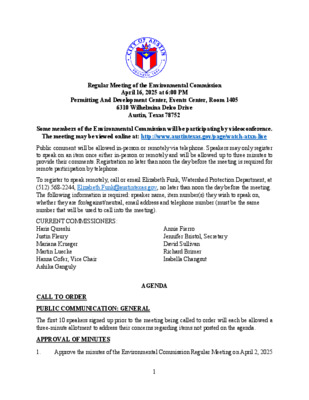
Regular Meeting of the Environmental Commission April 16, 2025 at 6:00 PM Permitting And Development Center, Events Center, Room 1405 6310 Wilhelmina Delco Drive Austin, Texas 78752 Some members of the Environmental Commission will be participating by videoconference. The meeting may be viewed online at: http://www.austintexas.gov/page/watch-atxn-live Public comment will be allowed in-person or remotely via telephone. Speakers may only register to speak on an item once either in-person or remotely and will be allowed up to three minutes to provide their comments. Registration no later than noon the day before the meeting is required for remote participation by telephone. To register to speak remotely, call or email Elizabeth Funk, Watershed Protection Department, at (512) 568-2244, Elizabeth.Funk@austintexas.gov, no later than noon the day before the meeting. The following information is required: speaker name, item number(s) they wish to speak on, whether they are for/against/neutral, email address and telephone number (must be the same number that will be used to call into the meeting). CURRENT COMMISSIONERS: Haris Qureshi Justin Fleury Mariana Krueger Martin Luecke Hanna Cofer, Vice Chair Ashika Ganguly Annie Fierro Jennifer Bristol, Secretary David Sullivan Richard Brimer Isabella Changsut CALL TO ORDER PUBLIC COMMUNICATION: GENERAL AGENDA The first 10 speakers signed up prior to the meeting being called to order will each be allowed a three-minute allotment to address their concerns regarding items not posted on the agenda. APPROVAL OF MINUTES 1. Approve the minutes of the Environmental Commission Regular Meeting on April 2, 2025 1 PUBLIC HEARINGS 2. Name: Flatz-130 SP-2024-0298D Applicant: Ted McConaghy (Kleinfelder) Location: 7400 Zekelman Blvd, Austin, TX 78724 Council District: Council District does not apply in Extraterritorial Jurisdiction Staff: David Michael, Environmental Review Specialist, Development Services Department, (512) 974-2263, david.michael@ausitntexas.gov Applicant request: Request to vary from a) LDC 25-8-302 to allow up to 600 SF of building on slopes over 25%, and to allow up to 3,000 SF of parking area on slopes over 15%; b) LDC 25-8-341 to allow up to 11 feet of cut, and c) LDC 25-8-342 to allow up to 16 feet of fill. Staff Recommendation: Staff recommends this variance with conditions DISCUSSION AND ACTION ITEMS 3. Discussion and possible action on Environmental Commission committee membership FUTURE AGENDA ITEMS ADJOURNMENT The City of Austin is committed to compliance with the American with Disabilities Act. Reasonable modifications and equal access to communications will be provided upon request. Meeting locations are planned with …
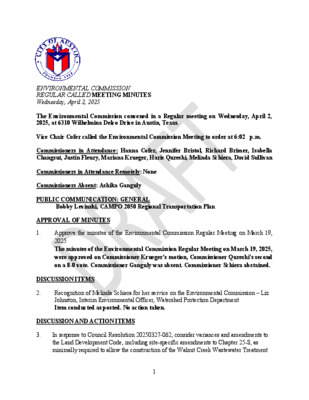
ENVIRONMENTAL COMMISSION REGULAR CALLED MEETING MINUTES Wednesday, April 2, 2025 The Environmental Commission convened in a Regular meeting on Wednesday, April 2, 2025, at 6310 Wilhelmina Delco Drive in Austin, Texas. Vice Chair Cofer called the Environmental Commission Meeting to order at 6:02 p.m. Commissioners in Attendance: Hanna Cofer, Jennifer Bristol, Richard Brimer, Isabella Changsut, Justin Fleury, Mariana Krueger, Haris Qureshi, Melinda Schiera, David Sullivan Commissioners in Attendance Remotely: None Commissioners Absent: Ashika Ganguly PUBLIC COMMUNICATION: GENERAL Bobby Levinski, CAMPO 2050 Regional Transportation Plan APPROVAL OF MINUTES 1. Approve the minutes of the Environmental Commission Regular Meeting on March 19, 2025 The minutes of the Environmental Commission Regular Meeting on March 19, 2025, were approved on Commissioner Krueger’s motion, Commissioner Qureshi’s second on a 8-0 vote. Commissioner Ganguly was absent. Commissioner Schiera abstained. DISCUSSION ITEMS 2. Recognition of Melinda Schiera for her service on the Environmental Commission – Liz Johnston, Interim Environmental Officer, Watershed Protection Department Item conducted as posted. No action taken. DISCUSSION AND ACTION ITEMS 3. In response to Council Resolution 20250327-062, consider variances and amendments to the Land Development Code, including site-specific amendments to Chapter 25-8, as minimally required to allow the construction of the Walnut Creek Wastewater Treatment 1 Plant Enhancement and Expansion Project – Leslie Lilly, Environmental Program Manager, Watershed Protection Department (WPD) Speakers: Leslie Lilly, WPD Charles Celauro, Austin Water (AW) Bobby Levinski, Save Our Springs Liz Johnston, Interim Environmental Officer, WPD Naomi Rotramel, City Arborist, Development Shay Ralls Roalson, Director, AW Erik Kunkel, Capitol Delivery Services A motion to recommend variances and amendments to the Land Development Code, including site-specific amendments to Chapter 25-8, as minimally required to allow the construction of the Walnut Creek Wastewater Treatment Plant Enhancement and Expansion Project, with additional recommendations, passed on Commissioner Bristol’s motion, Commissioner Sullivan’s second, on an 8–1 vote. Commissioner Ganguly was absent. Vice Chair Cofer called a recess at 8:43. The meeting reconvened at 8:50. 4. Election of Environmental Commission Officers for May 1, 2025 through April 30, 2026 term. A motion to nominate Commissioner Bristol as chair was approved on Commissioner Cofer’s motion on a 9-0 vote. Commissioner Ganguly was absent. A motion to nominate Commissioner Krueger as vice-chair was approved on Commissioner Bristol’s motion on a 9-0 vote. Commissioner Ganguly was absent. Commissioner Brimer nominated Commissioner Sullivan for secretary. Sullivan declined the nomination. A motion to nominate Commissioner Cofer as secretary was …

CWQZ C W Q Z Z C W Q QZ C W C W Q Z CWQZ C W Q Z C W Q Z CWQZ CWQZ CWQZ C W Q Z Z Q W C C W Q Z FM 973 Q Z C W Q Z W C Z Q W C CWQZ Z Q W C C W Q Z CWQZ C W Q Z CWQZ CWQZ 100 YR CALCULATED FLOODPLAIN CWQZ CWQZ CWQZ CWQZ CWQZ CWQZ Q Z C W C W Q Z C W Q Z C W Q Z CWQZ CWQZ CWQZ CWQZ CWQZ CWQZ CWQZ Q Z W C C W Q Z C W Q Z C W Q Z CWQZ Z Q W C HALF CRITICAL WATER QUALITY ZONE C W Q Z QZ W C QZ W C C W Q Z C W Q Z CWQZ Z C W Q CWQZ Q Z W C Z Q W C Z Q W C Z C W Q Q Z C W Z Q W C C W Q Z Z Q W C QZ C W C W QZ Q Z W C C W Q Z Z Q W C C W Q Z Z Q W C Z Q W C Z Q W C Q Z C W Z Q W C 495 CWQZ C W Q Z CWQZ C W Q Z CREEK CENTERLINE 5 0 5 5 1 0 C W QZ QZ W C Z Q W C Z Q W C Z Q W C Z Q W C C W Q Z QZ W C C W Q Z Z Q W C QZ W C C W Q Z Z C W Q WETLAND C.E.F. SETBACK 5 1 5 0 2 5 5 2 5 5 1 0 CRITICAL WATER QUALITY ZONE 530 5 3 5 QZ C W QZ W C Z Q W C C W Q Z C W Q Z CWQZ C W Q Z CWQZ C W Q Z C W Q Z C W Q Z Z Q W C CWQZ C W Q Z CWQZ Z C W Q CWQZ C W Q Z CWQZ CWQZ Z Q W C CWQZ C W Q Z Z Q W C Z Q W C Z Q W C Z Q W C QZ …

A/L5.08 POLLINATOR MIX P EV 1 PLANTING PLAN - POLLINATOR GARDEN 1" = 20'-0" N G A R K I N O PLANT SCHEDULE - POLLINATOR GARDEN SYMBOL CODE QTY BOTANICAL / COMMON NAME SIZE/COND. REMARKS ORNAMENTAL TREES DT2 5 DIOSPYROS TEXANA TEXAS PERSIMMON 45 GAL SYMBOL CODE QTY BOTANICAL / COMMON NAME SIZE SPACING REMARKS SHRUBS AQ 5 ANISACANTHUS QUADRIFIDUS WRIGHTII FLAME ACANTHUS 5 GAL 48" o.c. FULL, MATCHING CT3 38 CONOCLINIUM GREGGII GREGG'S MISTFLOWER 3 GAL 36" o.c. FULL, MATCHING LG2 19 LEUCOPHYLLUM FRUTESCENS `GREEN CLOUD` GREEN CLOUD TEXAS SAGE 5 GAL 48" o.c. FULL, MATCHING RO2 29 ROSMARINUS OFFICINALIS ROSEMARY 3 GAL 36" o.c. FULL, MATCHING SC2 18 SANTOLINA CHAMAECYPARISSUS LAVENDER COTTON 3 GAL 36" o.c. FULL, MATCHING SH2 26 SCIRPOIDES HOLOSCHOENUS ROUNDHEAD BULRUSH 5 GAL 36" o.c. TC 65 TEUCRIUM CHAMAEDRYS CREEPING GERMANDER 3 GAL 24" o.c. FULL,MATCHING m o c . s p d o o w t s e w (cid:19) (cid:21) (cid:22) e (cid:87) (cid:76) (cid:88) (cid:54) (cid:15) (cid:92) (cid:83) (cid:91) (cid:40) (cid:70) (cid:68) (cid:83) o (cid:48) (cid:17) (cid:49) (cid:20) (cid:19) (cid:26) (cid:27) (cid:20) (cid:22) (cid:27) (cid:19) (cid:16) (cid:24) (cid:27) (cid:23) (cid:12) (cid:21) (cid:20) (cid:24) (cid:11) e n o h P (cid:28) (cid:24) (cid:26) (cid:27) (cid:26) (cid:59) T (cid:15) n (cid:76) (cid:87) (cid:86) (cid:88) (cid:36) (cid:19) (cid:24) (cid:20) (cid:24) (cid:16) (cid:26) (cid:22) (cid:28) (cid:12) (cid:27) (cid:27) (cid:27) (cid:11) e e r F l l o T . c n I , s e c i v r e S l a n o i s s e f o r P d o o w t s e W 9 6 4 F - . O N N O I T A R T S I G E R M R I F E P B T - 0 0 0 8 0 0 0 1 S L - . O N N O I T A R T S I G E R M R I F S L P B T AUSTIN ECM APPROVED PLANTING - DROUGHT TOLERANT ORNAMENTAL GRASSES MC2 68 MUHLENBERGIA CAPILLARIS PINK MUHLY 5 GAL 36" o.c. FULL, MATCHING PV 45 PANICUM VIRGATUM SWITCH GRASS 5 GAL 36" o.c. FULL, MATCHING DRY CREEK BED ORNAMENTAL GRASSES T Y P . D/L5.08 C/L5.08 B/L5.08 NT 90 NASSELLA TENUISSIMA MEXICAN FEATHER GRASS 3 GAL 18" o.c. FULL, MATCHING SOD CD 2,690 SF CYNODON DACTYLON BERMUDA GRASS SOD SOLID, ROLLED TIGHT, …
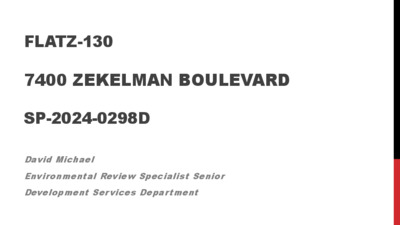
FLATZ-130 7400 ZEKELMAN BOULEVARD SP-2024-0298D David Michael Environmental Review Specialist Senior Development Services Department PROPERTY DATA • Extraterritorial Jurisdiction • Desired Development Zone • Suburban Classification • Decker Creek Watershed • Not located over Edwards Aquifer Recharge Zone • Critical Environmental Features – Critical Water Quality Zone, Wetlands LOCATION Site Location Austin ETJ Austin City Limits Edwards Aquifer Recharge Zone Edwards Aquifer Contributing Zone LOCATION HW130 LOCATION HW130 ELEVATIONS CRITICAL WATER QUALITY ZONES LOCATION POST OAK SAVANNAH VARIANCE REQUESTS • Request to vary from LDC 25-8-341 to allow cut up to 11 feet. • Request to vary from LDC 25-8-342 to allow fill up to 16 feet and construct a water quality control facility over 4 feet on slopes with a gradient of more than 15%. • Request to vary LDC Sec. 25-8-302 to allow 600 SF of building to be located on slopes over 25%, and 3,000 SF of parking area to be located on slopes over 15%. PROPOSED CUT & FILL PROPOSED CONSTRUCTION ON SLOPES VARIANCE FINDINGS IN SUMMARY • Variances for grading have been granted for similar projects. • Requested grading and construction on slopes are not design decisions, and the project provides greater environmental protection with increased landscaping. • The project does not create a significant probability of harmful environmental consequences. • The variance will result in water quality that is at least equal to the water quality achievable without the variance. STAFF DETERMINATION Staff recommends this variance, having determined the findings of fact have been met. VARIANCE RECOMMENDATIONS Staff Conditions: 1. The natural draw adjacent to buildings 3 and 7 is designed as a sunken garden that filters runoff with a trickle channel and pollinator plantings. 2. The site will meet full landscape requirements as specified by code despite the site being located in the ETJ, where landscape ordinance do not apply. Notably, all parking spaces will be within 50 LF radius of a shade tree 3. All new 3:1 slopes will use the 609S upland seed mix with additional shrubs and trees provided near the base of the slopes to assist with stabilization. . APPLICANT PRESENTATION
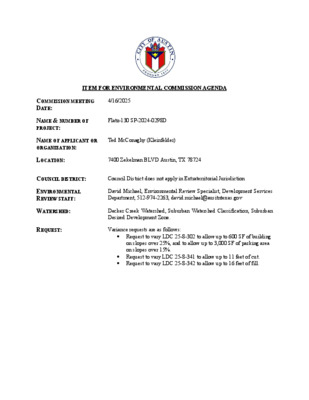
ITEM FOR ENVIRONMENTAL COMMISSION AGENDA COMMISSION MEETING DATE: 4/16/2025 NAME & NUMBER OF PROJECT: NAME OF APPLICANT OR ORGANIZATION: Flatz-130 SP-2024-0298D Ted McConaghy (Kleinfelder) LOCATION: 7400 Zekelman BLVD Austin, TX 78724 COUNCIL DISTRICT: Council District does not apply in Extraterritorial Jurisdiction ENVIRONMENTAL REVIEW STAFF: WATERSHED: David Michael, Environmental Review Specialist, Development Services Department, 512-974-2263, david.michael@ausitntexas.gov Decker Creek Watershed, Suburban Watershed Classification, Suburban Desired Development Zone. REQUEST: Variance requests are as follows: • Request to vary LDC 25-8-302 to allow up to 600 SF of building on slopes over 25%, and to allow up to 3,000 SF of parking area on slopes over 15%. • Request to vary LDC 25-8-341 to allow up to 11 feet of cut. • Request to vary LDC 25-8-342 to allow up to 16 feet of fill. Page 2 of 2 STAFF RECOMMENDATION: Staff recommends these variances, having determined the findings of fact to have been met. STAFF CONDITIONS: • All new 3:1 slopes will use the 609S upland seed mix with additional shrubs and trees provided near the base of the slopes to assist with stabilization. • The natural draw adjacent to buildings 3 and 7 is designed as a sunken garden that filters runoff with a trickle channel and pollinator plantings. • The site will meet full landscape requirements as specified by code despite the site being in the ETJ, where landscape ordinance do not apply. Notably, all parking spaces will be within 50 LF radius of a shade tree. Development Services Department Staff Recommendations Concerning Required Findings Project Name: Flatz-130 SP-2024-0298D Ordinance Standard: LDC Sec. 25-8-302 Variance Request: Request to vary LDC Sec. 25-8-302 to allow 600 SF of building on slopes over 25%, and to allow 3,000 SF of parking area to be located on slopes over 15%. A. Land Use Commission variance determinations from Chapter 25-8-41 of the City Code: 1. The requirement will deprive the applicant of a privilege available to owners of other similarly situated property with approximately contemporaneous development subject to similar code requirements; Yes. Not allowing the requested 600 SF of building area on slopes over 25%, and 3,000 SF of parking area on slopes over 15% will deprive the applicant of a privilege available to owners of other similarly situated property with approximately contemporaneous development subject to similar code requirements. This variance from code is necessary to integrate a typical multifamily housing development within a typical …
Play video
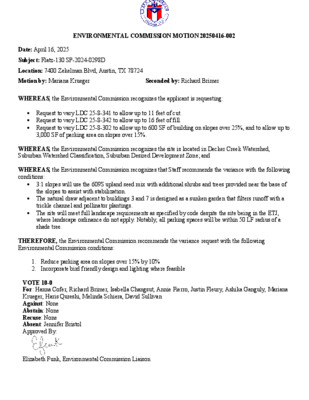
ENVIRONMENTAL COMMISSION MOTION 20250416-002 Date: April 16, 2025 Subject: Flatz-130 SP-2024-0298D Location: 7400 Zekelman Blvd, Austin, TX 78724 Motion by: Mariana Krueger Seconded by: Richard Brimer WHEREAS, the Environmental Commission recognizes the applicant is requesting: • Request to vary LDC 25-8-341 to allow up to 11 feet of cut. • Request to vary LDC 25-8-342 to allow up to 16 feet of fill. • Request to vary LDC 25-8-302 to allow up to 600 SF of building on slopes over 25%, and to allow up to 3,000 SF of parking area on slopes over 15%. WHEREAS, the Environmental Commission recognizes the site is located in Decker Creek Watershed, Suburban Watershed Classification, Suburban Desired Development Zone; and WHEREAS, the Environmental Commission recognizes that Staff recommends the variance with the following conditions: • 3:1 slopes will use the 609S upland seed mix with additional shrubs and trees provided near the base of the slopes to assist with stabilization. • The natural draw adjacent to buildings 3 and 7 is designed as a sunken garden that filters runoff with a trickle channel and pollinator plantings. • The site will meet full landscape requirements as specified by code despite the site being in the ETJ, where landscape ordinance do not apply. Notably, all parking spaces will be within 50 LF radius of a shade tree. THEREFORE, the Environmental Commission recommends the variance request with the following Environmental Commission conditions: 1. Reduce parking area on slopes over 15% by 10% 2. Incorporate bird friendly design and lighting where feasible VOTE 10-0 For: Hanna Cofer, Richard Brimer, Isabella Changsut, Annie Fierro, Justin Fleury, Ashika Ganguly, Mariana Krueger, Haris Qureshi, Melinda Schiera, David Sullivan Against: None Abstain: None Recuse: None Absent: Jennifer Bristol Approved By: Elizabeth Funk, Environmental Commission Liaison
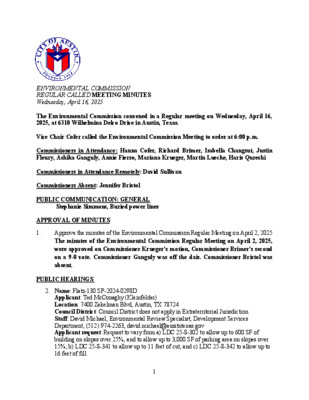
ENVIRONMENTAL COMMISSION REGULAR CALLED MEETING MINUTES Wednesday, April 16, 2025 The Environmental Commission convened in a Regular meeting on Wednesday, April 16, 2025, at 6310 Wilhelmina Delco Drive in Austin, Texas. Vice Chair Cofer called the Environmental Commission Meeting to order at 6:00 p.m. Commissioners in Attendance: Hanna Cofer, Richard Brimer, Isabella Changsut, Justin Fleury, Ashika Ganguly, Annie Fierro, Mariana Krueger, Martin Luecke, Haris Qureshi Commissioners in Attendance Remotely: David Sullivan Commissioners Absent: Jennifer Bristol PUBLIC COMMUNICATION: GENERAL Stephanie Simmons, Buried power lines APPROVAL OF MINUTES 1. Approve the minutes of the Environmental Commission Regular Meeting on April 2, 2025 The minutes of the Environmental Commission Regular Meeting on April 2, 2025, were approved on Commissioner Krueger’s motion, Commissioner Brimer’s second on a 9-0 vote. Commissioner Ganguly was off the dais. Commissioner Bristol was absent. PUBLIC HEARINGS 2. Name: Flatz-130 SP-2024-0298D Applicant: Ted McConaghy (Kleinfelder) Location: 7400 Zekelman Blvd, Austin, TX 78724 Council District: Council District does not apply in Extraterritorial Jurisdiction Staff: David Michael, Environmental Review Specialist, Development Services Department, (512) 974-2263, david.michael@ausitntexas.gov Applicant request: Request to vary from a) LDC 25-8-302 to allow up to 600 SF of building on slopes over 25%, and to allow up to 3,000 SF of parking area on slopes over 15%; b) LDC 25-8-341 to allow up to 11 feet of cut, and c) LDC 25-8-342 to allow up to 16 feet of fill. 1 Staff Recommendation: Staff recommends this variance with conditions Speakers: David Michael, DSD Ted McConaghy, speaking on behalf of the applicant Arthur Walts Mike McDougal, DSD A motion to close the public hearing passed on Commissioner Krueger’s motion, Commissioner Qureshi’s second, on a 10-0 vote. Commissioner Bedford was absent. A motion to recommend Flatz-130 with conditions passed on Commissioner Krueger’s motion, Commissioner Brimer’s second, on a 10–0 vote. Commissioner Bristol was absent. DISCUSSION AND ACTION ITEMS 3. Discussion and possible action on Environmental Commission committee membership The commission nominated Commissioner Luecke as a member of the Urban Forestry Committee. FUTURE AGENDA ITEMS Commissioner Qureshi mentioned a development related to Tesla. Liz Johnston (WPD) clarified they are not within the City of Austin. Commissioner Brimer asked for an update on the request to hear about CAMPO. Elizabeth Funk (WPD) said the request was emailed and will follow up. Commissioner Changsut requested a discussion and action item regarding a planting and harvesting rare earth elements research project related to the …
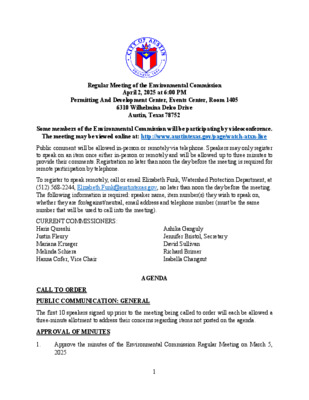
Regular Meeting of the Environmental Commission April 2, 2025 at 6:00 PM Permitting And Development Center, Events Center, Room 1405 6310 Wilhelmina Delco Drive Austin, Texas 78752 Some members of the Environmental Commission will be participating by videoconference. The meeting may be viewed online at: http://www.austintexas.gov/page/watch-atxn-live Public comment will be allowed in-person or remotely via telephone. Speakers may only register to speak on an item once either in-person or remotely and will be allowed up to three minutes to provide their comments. Registration no later than noon the day before the meeting is required for remote participation by telephone. To register to speak remotely, call or email Elizabeth Funk, Watershed Protection Department, at (512) 568-2244, Elizabeth.Funk@austintexas.gov, no later than noon the day before the meeting. The following information is required: speaker name, item number(s) they wish to speak on, whether they are for/against/neutral, email address and telephone number (must be the same number that will be used to call into the meeting). CURRENT COMMISSIONERS: Haris Qureshi Justin Fleury Mariana Krueger Melinda Schiera Hanna Cofer, Vice Chair Ashika Ganguly Jennifer Bristol, Secretary David Sullivan Richard Brimer Isabella Changsut CALL TO ORDER PUBLIC COMMUNICATION: GENERAL AGENDA The first 10 speakers signed up prior to the meeting being called to order will each be allowed a three-minute allotment to address their concerns regarding items not posted on the agenda. APPROVAL OF MINUTES Approve the minutes of the Environmental Commission Regular Meeting on March 5, 2025 1 1. DISCUSSION ITEMS Recognition of Melinda Schiera for her service on the Environmental Commission – Liz Johnston, Interim Environmental Officer, Watershed Protection Department DISCUSSION AND ACTION ITEMS In response to Council Resolution 20250327-062, consider variances and amendments to the Land Development Code, including site-specific amendments to Chapter 25-8, as minimally required to allow the construction of the Walnut Creek Wastewater Treatment Plant Enhancement and Expansion Project – Leslie Lilly, Environment Conservation Manager, Watershed Protection Department Election of Environmental Commission Officers for May 1, 2025 through April 30, 2026 term. Discussion and possible action on Environmental Commission committee membership Discussion and recommendation on 2026 budget priorities from the Joint Sustainability Committee – Environmental Commissioner Haris Qureshi Discussion and recommendation on City-Wide On-Demand Micro Transit to Parks and Recreation Centers – Environmental Commissioners Richard Brimer and Haris Qureshi FUTURE AGENDA ITEMS ADJOURNMENT The City of Austin is committed to compliance with the American with Disabilities Act. Reasonable modifications and …

Walnut Creek Wastewater Treatment Plant Enhancement and Expansion Project Capital Improvement Project 3023.046 Leslie Lilly Watershed Protection Environmental Conservation Program Manager C I T Y O F A U S T I N W A T E R S H E D P R O T E C T I O N D E P A R T M E N T W a l n u t C r e e k W W T P C I T Y O F A U S T I N W A T E R S H E D P R O T E C T I O N D E P A R T M E N T 2 Walnut Creek Wastewater Treatment Facility C I T Y O F A U S T I N W A T E R S H E D P R O T E C T I O N D E P A R T M E N T 3 Walnut Creek Wastewater Treatment Facility C I T Y O F A U S T I N W A T E R S H E D P R O T E C T I O N D E P A R T M E N T 4 Colorado River The Enhancement and Expansion Project C I T Y O F A U S T I N W A T E R S H E D P R O T E C T I O N D E P A R T M E N T 5 Construction in the CWQZ LDC 25-8-261 To allow construction of a floodplain wall within a Critical Water Quality Zone (CWQZ). C I T Y O F A U S T I N W A T E R S H E D P R O T E C T I O N D E P A R T M E N T 6 Mitigation for impact to CWQZ C I T Y O F A U S T I N W A T E R S H E D P R O T E C T I O N D E P A R T M E N T 7 Construction on Slopes LDC 25-8-301 Administrative approval of roadway or driveway constructed on slopes in excess of 15% C I T Y O F A U S T I …
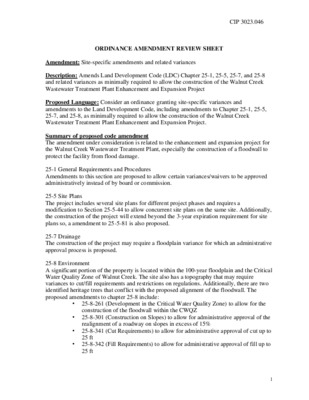
CIP 3023.046 ORDINANCE AMENDMENT REVIEW SHEET Amendment: Site-specific amendments and related variances Description: Amends Land Development Code (LDC) Chapter 25-1, 25-5, 25-7, and 25-8 and related variances as minimally required to allow the construction of the Walnut Creek Wastewater Treatment Plant Enhancement and Expansion Project Proposed Language: Consider an ordinance granting site-specific variances and amendments to the Land Development Code, including amendments to Chapter 25-1, 25-5, 25-7, and 25-8, as minimally required to allow the construction of the Walnut Creek Wastewater Treatment Plant Enhancement and Expansion Project. Summary of proposed code amendment The amendment under consideration is related to the enhancement and expansion project for the Walnut Creek Wastewater Treatment Plant, especially the construction of a floodwall to protect the facility from flood damage. 25-1 General Requirements and Procedures Amendments to this section are proposed to allow certain variances/waivers to be approved administratively instead of by board or commission. 25-5 Site Plans The project includes several site plans for different project phases and requires a modification to Section 25-5-44 to allow concurrent site plans on the same site. Additionally, the construction of the project will extend beyond the 3-year expiration requirement for site plans so, a amendment to 25-5-81 is also proposed. 25-7 Drainage The construction of the project may require a floodplain variance for which an administrative approval process is proposed. 25-8 Environment A significant portion of the property is located within the 100-year floodplain and the Critical Water Quality Zone of Walnut Creek. The site also has a topography that may require variances to cut/fill requirements and restrictions on regulations. Additionally, there are two identified heritage trees that conflict with the proposed alignment of the floodwall. The proposed amendments to chapter 25-8 include: • 25-8-261 (Development in the Critical Water Quality Zone) to allow for the construction of the floodwall within the CWQZ • 25-8-301 (Construction on Slopes) to allow for administrative approval of the realignment of a roadway on slopes in excess of 15% • 25-8-341 (Cut Requirements) to allow for administrative approval of cut up to • 25-8-342 (Fill Requirements) to allow for administrative approval of fill up to 25 ft 25 ft 1 • 25-8-264 & 25-8-263 (Heritage Trees) to allow for administrative approval of CIP 3023.046 removal of two heritage trees Background: The Walnut Creek Wastewater Treatment Plant (WWTP) receives wastewater flow from Austin Water's wastewater collection system. The plant was originally built in …
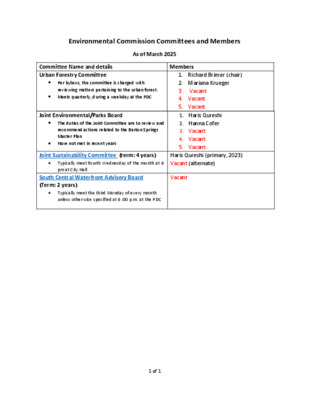
As of March 2025 Members Environmental Commission Committees and Members Committee Name and details Urban Forestry Committee • Per bylaws, the committee is charged with reviewing matters pertaining to the urban forest. • Meets quarterly, during a weekday at the PDC Joint Environmental/Parks Board The duties of the Joint Committee are to review and recommend actions related to the Barton Springs Master Plan • Have not met in recent years 1. Richard Brimer (chair) 2. Mariana Krueger 3. Vacant 4. Vacant 5. Vacant 1. Haris Qureshi 2. Hanna Cofer 3. Vacant 4. Vacant 5. Vacant Joint Sustainability Committee (term: 4 years) Typically meet fourth Wednesday of the month at 6 pm at City Hall Haris Qureshi (primary, 2023) Vacant (alternate) South Central Waterfront Advisory Board (Term: 2 years) Vacant Typically meet the third Monday of every month unless otherwise specified at 6 :00 p.m. at the PDC • • • 1 of 1
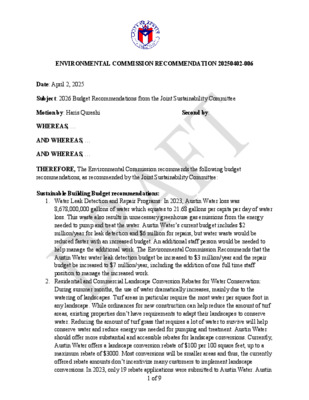
ENVIRONMENTAL COMMISSION RECOMMENDATION 20250402-006 Date: April 2, 2025 Subject: 2026 Budget Recommendations from the Joint Sustainability Committee Motion by: Haris Qureshi WHEREAS, … AND WHEREAS, … AND WHEREAS, … THEREFORE, The Environmental Commission recommends the following budget recommendations, as recommended by the Joint Sustainability Committee: Sustainable Building Budget recommendations: Second by: 1. Water Leak Detection and Repair Programs: In 2023, Austin Water loss was 8,678,000,000 gallons of water which equates to 21.68 gallons per capita per day of water loss. This waste also results in unnecessary greenhouse gas emissions from the energy needed to pump and treat the water. Austin Water’s current budget includes $2 million/year for leak detection and $6 million for repairs, but water waste would be reduced faster with an increased budget. An additional staff person would be needed to help manage the additional work. The Environmental Commission Recommends that the Austin Water water leak detection budget be increased to $3 million/year and the repair budget be increased to $7 million/year, including the addition of one full time staff position to manage the increased work. 2. Residential and Commercial Landscape Conversion Rebates for Water Conservation: During summer months, the use of water dramatically increases, mainly due to the watering of landscapes. Turf areas in particular require the most water per square foot in any landscape. While ordinances for new construction can help reduce the amount of turf areas, existing properties don’t have requirements to adapt their landscapes to conserve water. Reducing the amount of turf grass that requires a lot of water to survive will help conserve water and reduce energy use needed for pumping and treatment. Austin Water should offer more substantial and accessible rebates for landscape conversions. Currently, Austin Water offers a landscape conversion rebate of $100 per 100 square feet, up to a maximum rebate of $3000. Most conversions will be smaller areas and thus, the currently offered rebate amounts don’t incentivize many customers to implement landscape conversions. In 2023, only 19 rebate applications were submitted to Austin Water. Austin 1 of 9 Water should implement a tiered rebate structure that offers more rebate money for smaller areas of landscape conversion for residential properties and should substantially increase the maximum rebate offered. As suggested by the Get Fertilizer Wiser campaign, there should also be incentives that are more easily accessible to individuals who may not need to fully remove turf grass in order to …
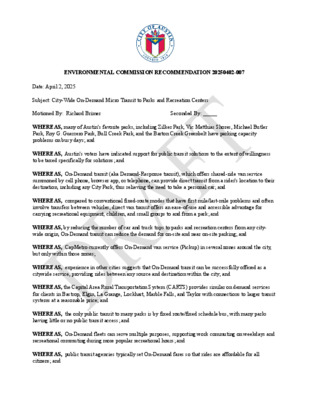
ENVIRONMENTAL COMMISSION RECOMMENDATION 20250402-007 Seconded By: _____ Date: April 2, 2025 Subject: City-Wide On-Demand Micro Transit to Parks and Recreation Centers Motioned By: Richard Brimer WHEREAS, many of Austin's favorite parks, including Zilker Park, Vic Matthias Shores, Michael Butler Park, Roy G. Guerrero Park, Bull Creek Park, and the Barton Creek Greenbelt have parking capacity problems on busy days; and WHEREAS, Austin's voters have indicated support for public transit solutions to the extent of willingness to be taxed specifically for solutions; and WHEREAS, On-Demand transit (aka Demand-Response transit), which offers shared-ride van service summoned by cell phone, browser app, or telephone, can provide direct transit from a rider's location to their destination, including any City Park, thus relieving the need to take a personal car; and WHEREAS, compared to conventional fixed-route modes that have first mile/last-mile problems and often involve transfers between vehicles, direct van transit offers an ease-of-use and accessible advantage for carrying recreational equipment, children, and small groups to and from a park; and WHEREAS, by reducing the number of car and truck trips to parks and recreation centers from any city- wide origin, On-Demand transit can reduce the demand for on-site and near on-site parking; and WHEREAS, CapMetro currently offers On-Demand van service (Pickup) in several zones around the city, but only within those zones; WHEREAS, experience in other cities suggests that On-Demand transit can be successfully offered as a citywide service, providing rides between any source and destination within the city; and WHEREAS, the Capital Area Rural Transportation System (CARTS) provides similar on demand services for clients in Bastrop, Elgin, La Grange, Lockhart, Marble Falls, and Taylor with connections to larger transit systems at a reasonable price; and WHEREAS, the only public transit to many parks is by fixed route/fixed schedule bus, with many parks having little or no public transit access; and WHEREAS, On-Demand fleets can serve multiple purposes, supporting work commuting on weekdays and recreational commuting during more popular recreational hours; and WHEREAS, public transit agencies typically set On-Demand fares so that rides are affordable for all citizens; and WHEREAS, On-Demand service requires no physical infrastructure, so is more adaptable to long-term changes in the configuration of the city and can be financed with much lower capital expenditure than other forms of public transit with the possible exception of conventional buses; and WHEREAS, commercially available modeling technology is available that would support rich, formal …